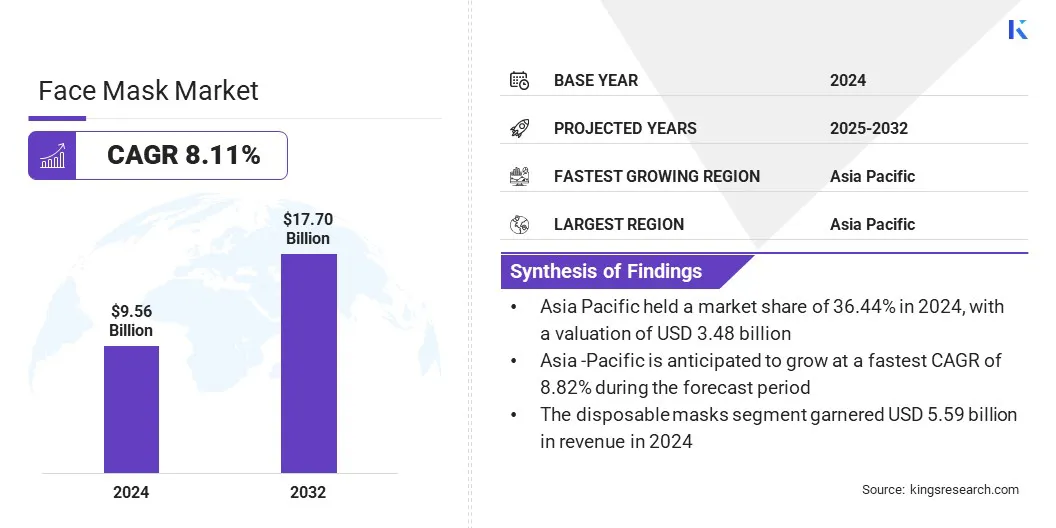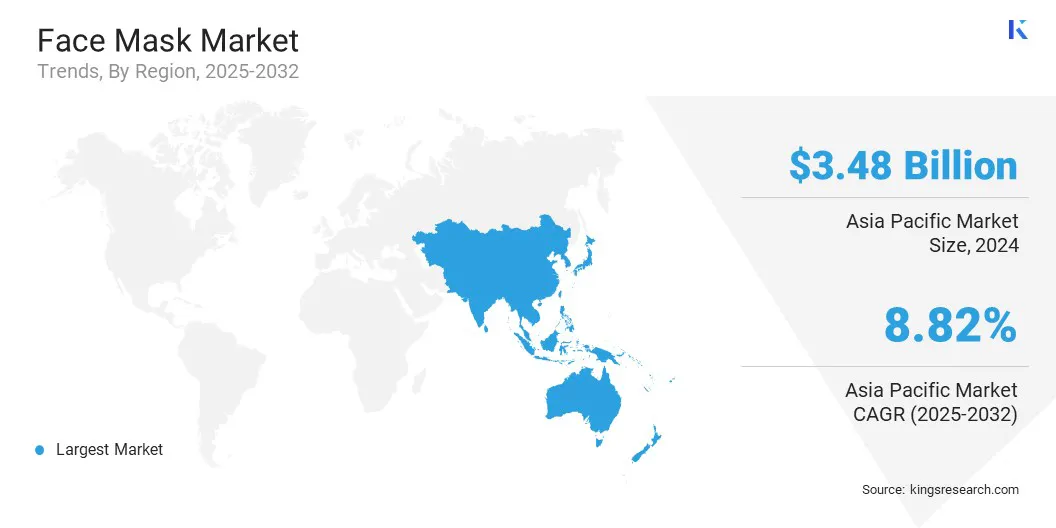buyNow
Face Mask Market
Face Mask Market Size, Share, Growth & Industry Analysis, By Product Type (Surgical Masks, Respirators, Dust Masks, Others), By Material (Polypropylene (PP), Polyurethane, Polyester, Others), By Usability (Disposable Masks, Reusable Masks), By End-User Industry, and Regional Analysis, 2025-2032
pages: 180 | baseYear: 2024 | release: July 2025 | author: Versha V.
Market Definition
A face mask is a protective covering worn over the nose and mouth to reduce the transmission of airborne particles, microorganisms, and pollutants. It is commonly used in healthcare settings, industrial environments, and public spaces to prevent the spread of infectious diseases, filter out harmful substances, and provide respiratory protection. Face masks can be disposable or reusable and include types such as surgical masks, N95 respirators, and cloth masks.
Face Mask Market Overview
The global face mask market size was valued at USD 9.56 billion in 2024 and is projected to grow from USD 10.26 billion in 2025 to USD 17.70 billion by 2032, exhibiting a CAGR of 8.11% during the forecast period. This growth is attributed to the rising exposure to unhealthy air in densely populated regions, leading to increased adoption of face masks for respiratory protection.
Ongoing concerns over air quality are also prompting governments and individuals to respond to persistent air quality concerns by prioritizing protective wear, sustaining demand across both disposable and reusable mask segments.
Key Market Highlights:
- The face mask industry size was recorded at USD 9.56 billion in 2024.
- The market is projected to grow at a CAGR of 8.11% from 2025 to 2032.
- Asia Pacific held a share of 36.44% in 2024, valued at USD 3.48 billion.
- The surgical masks segment garnered USD 3.95 billion in revenue in 2024.
- The polypropylene (PP) segment is expected to reach USD 8.62 billion by 2032.
- The reusable masks segment is anticipated to grow at a CAGR of 9.61% over the forecast period.
- The hospitals & clinics segment held a market share of 33.26% in 2024.
- Europe is anticipated to grow at a CAGR of 8.53% through the projection period.
Major companies operating in the face mask industry are 3M, Kimberly-Clark Worldwide, Inc., Cardinal Health, AlphaProTech, Ambu A/S, Medline Industries, Inc., Mölnlycke AB, Prestige Ameritech, Markrite, CNTUS, IREMA Ireland, Magnum Health And Safety Pvt. Ltd., Z Plus Disposable, Cartel Health Care Pvt. Ltd. and Medicom.
The market is expanding due to the growing prevalence of respiratory diseases such as COPD and asthma, which is prompting individuals to adopt preventive health measures and rely on face masks as a practical solution to reduce exposure to harmful airborne particles.
- According to the World Health Organization and the Chinese Center for Disease Control and Prevention, over 1.5 million individuals in China were screened for COPD between 2021 and 2023 through national health programs using structured assessments and portable spirometers.

Market Driver
Rising Air Pollution Levels
Increasing air pollution is creating a strong demand for face masks to protect against airborne pollutants and particulate matter. Prolonged exposure to harmful pollutants such as PM2.5, dust and toxic gases is leading to growing health concerns and prompting individuals to use protective masks for daily outdoor activities.
This shift is prominent in countries with poor air quality indexes, where masks are used increasingly. This is supporting steady demand for both disposable and reusable masks, fostering the expansion of the face mask market.
- According to the World Health Organization, 99% of the global population is exposed to air pollution levels exceeding safety limits, with low- and middle-income countries most affected. This has increased the use of protective masks during daily outdoor activities.
Market Challenge
Availability of Counterfeit Products
The widespread availability of counterfeit products presents a major challenge to the expansion of the face mask market, as these substandard products often do not meet essential safety and filtration standards and expose users to potential health risks while weakening confidence in trusted brands.
The fake masks are commonly distributed through unregulated channels, which makes their identification and control increasingly complex. This problem is concerning in healthcare and industrial environments where ineffective protection can lead to severe outcomes and tighter regulatory surveillance enforcement.
To address this challenge, companies are adopting integrated strategies that enhance both product security and consumer trust. They are embedding authentication features such as QR codes and holographic tags into packaging while strengthening supply chains through exclusive partnerships with certified distributors.
Additionally, brands are investing in awareness programs that guide consumers in identifying genuine products, which further supports their aim to ensure product authenticity and safeguard public health.
Market Trend
Shift Toward Sustainable and Reusable Masks
The shift toward sustainable and reusable masks is emerging as a key trend in the face mask market as consumers become more environmentally conscious and increasingly aware of the impact of single-use products. Manufacturers are responding by developing high-quality masks made from durable and washable materials that offer extended usability without compromising protection.
It reduces waste and offers cost-effective solutions for regular users by eliminating the need for frequent replacements and promoting long-term usage without compromising safety or comfort. The trend is further supported by growing demand in sectors such as agriculture and construction, where long-term use and environmental responsibility are key considerations.
- In July 2024, BASE CAMP launched the N Plus Dust Mask Combo Kit, featuring a proprietary MNL material blend, ergonomic ear strap design, and 99.6% particle filtration efficiency, targeting woodworking professionals and sustainable agriculture sectors with enhanced comfort and respiratory protection.
Face Mask Market Report Scope
|
Segmentation |
Details |
|
By Product Type |
Surgical Masks, Respirators, Dust Masks, Others |
|
By Material |
Polypropylene (PP), Polyurethane, Polyester, Others |
|
By Usability |
Disposable Masks, Reusable Masks |
|
By End-User Industry |
Hospitals & Clinics, Ambulatory Surgical Centers, Research Institutions, Construction, Food Processing, Others |
|
By Region |
North America: U.S., Canada, Mexico |
|
Europe: France, UK, Spain, Germany, Italy, Russia, Rest of Europe | |
|
Asia-Pacific: China, Japan, India, Australia, ASEAN, South Korea, Rest of Asia-Pacific | |
|
Middle East & Africa: Turkey, U.A.E., Saudi Arabia, South Africa, Rest of Middle East & Africa | |
|
South America: Brazil, Argentina, Rest of South America |
Market Segmentation
- By Product Type (Surgical Masks, Respirators, Dust Masks, and Others): The surgical masks segment earned USD 3.95 billion in 2024, mainly due to their widespread use in medical settings and public health practices driven by infection control protocols.
- By Material (Polypropylene (PP), Polyurethane, Polyester, and Others): The polypropylene (PP) segment held a share of 47.21% in 2024, fueled by its high filtration efficiency, breathability, and cost-effectiveness in mass production.
- By Usability (Disposable Masks and Reusable Masks): The disposable masks segment is projected to reach USD 9.53 billion by 2032, owing to increasing demand in healthcare and industrial sectors for single-use, hygienic respiratory protection.
- By End-User Industry (Hospitals & Clinics, Ambulatory Surgical Centers, Research Institutions, Construction, Food Processing, and Others): The construction segment is anticipated to grow at a CAGR of 9.72% over the forecast period, fostered by stricter workplace safety regulations and rising awareness of respiratory health among workers.
Face Mask Market Regional Analysis
Based on region, the market has been classified into North America, Europe, Asia Pacific, Middle East & Africa, and South America.

The Asia-Pacific face mask market accounted for a share of 36.44% in 2024, valued at USD 3.48 billion. This dominance is reinforced by the widespread exposure to polluted air and the growing need for respiratory protection across densely populated countries in the region. With several of the world's most polluted nations, declining air quality, particularly in urban areas, is accelerating the adoption of face masks among both consumers and industrial workers.
Additionally, the market is expanding due to rising public health awareness and increasing focus on preventive healthcare practices across the region. Governments in the Asia Pacific market are introducing stricter safety mandates in response to environmental and occupational risks, which is boosting consistent mask usage across healthcare, industrial, and public settings.
- According to the United Nations Environment Programme (UNEP) and IQAir (2023), nine East and Southeast Asian countries rank among the world’s 40 most polluted nations, with nearly all residents exposed to unhealthy air.
The Europe face mask industry is set to grow at a robust CAGR of 8.53% over the forecast period. This growth is attributed to the implementation of new air quality regulations across the region, which are increasing demand for protective respiratory equipment. The regional market further benefits from the enforcement of stricter limits on airborne pollutants, prompting individuals and workers to adopt face masks for daily protection.
As air pollution remains a serious health concern across urban centers, the regional market is witnessing rising public demand for accessible and effective respiratory solutions.
This growth is further propelled by a strong policy shift that prioritizes public health and environmental safety by enforcing stricter air quality standards and promoting widespread use of protective masks across urban and industrial areas. These initiatives are supporting consistent face mask usage across healthcare, industrial, and general consumer segments in the region.
- In April 2024, the European Parliament adopted new air quality standards under its revised Ambient Air Quality Directive to address air pollution, which causes around 300,000 premature deaths annually in the EU.
Regulatory Frameworks
- In the U.S., the Food and Drug Administration (FDA) regulates face masks used in healthcare and consumer markets, overseeing their safety, efficacy, labeling, and manufacturing practices. The agency ensures compliance with quality standards and monitors product recalls and post-market surveillance.
- In China, the National Medical Products Administration (NMPA) oversees the registration, production, and quality control of medical face masks in China. It mandates product testing, technical review, and certification to ensure masks meet national safety and filtration standards.
- In India, the Bureau of Indian Standards (BIS) regulates the manufacturing and certification of face masks by setting quality benchmarks under its IS specifications. It oversees material safety, bacterial filtration efficiency, and breathability, particularly for medical and industrial-grade masks.
- In the UK, the Medicines and Healthcare Products Regulatory Agency (MHRA) supervises the approval and monitoring of medical face masks. It ensures conformity with UKCA or CE markings, checks technical documentation, and verifies product claims.
Competitive Landscape
Major players in the face mask industry are expanding their product portfolios by acquiring established personal protective equipment brands to strengthen capabilities in respiratory protection. They are widening their global footprint to enhance accessibility and meet regional demand more effectively.
They are improving supply chain efficiency by optimizing distribution networks to expand manufacturing capacity and leveraging digital tools to ensure faster delivery and improved inventory management.
Additionally, manufacturers are investing in innovation to advance product quality and performance to support the development of next-generation protective solutions tailored to evolving industrial and healthcare needs.
- In May 2025, Protective Industrial Products (PIP) acquired Honeywell’s Personal Protective Equipment (PPE) business. The acquisition aims to expand global footprint by enhancing its capabilities in respiratory, head and hearing protection, while improving supply chain efficiency and accelerating innovation across critical safety product lines.
Key Companies in Face Mask Market:
- 3M
- Kimberly-Clark Worldwide, Inc
- Cardinal Health
- AlphaProTech
- Ambu A/S
- Medline Industries, Inc.
- Mölnlycke AB
- Prestige Ameritech
- Markrite
- CNTUS
- IREMA Ireland
- Magnum Health And Safety Pvt. Ltd
- Z Plus Disopsable
- Cartel Health Care Pvt. Ltd
- Medicom
Recent Developments (Product Launch)
- In March 2024, ResMed launched the AirFit F40, its most compact full-face CPAP mask, designed to offer a high-seal solution for sleep apnea patients. It features a soft silicone AdaptiSeal cushion and a fully flexible frame
